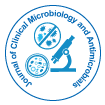
Journal of Clinical Microbiology and Antimicrobials
Open Access
+44-77-2385-9429

+44-77-2385-9429
Short Commentary - (2024)Volume 8, Issue 2
Neisseria cinerea, a member of the genus Neisseria, has gained attention in recent years as a potentially significant pathogen of the respiratory tract. While historically considered non-pathogenic, emerging evidence suggests its involvement in respiratory infections, highlighting the need for deeper examination into its microbiological characteristics, clinical relevance, and implications for public health.
Microbiological characteristics and taxonomy
Neisseria cinerea is a gram-negative diplococcus belonging to the family Neisseriaceae, closely related to other Neisseria species such as Neisseria meningitidis and Neisseria gonorrhoeae. It shares genetic and phenotypic traits with these pathogenic counterparts, including the ability to colonize mucosal surfaces of the human respiratory tract [1].
The bacterium exhibits unique biochemical properties, including catalase and oxidase positivity, and ferments glucose but not maltose or sucrose. These characteristics distinguish N. cinerea from other Neisseria species and underscore its potential as a respiratory pathogen in susceptible individuals [2].
Clinical relevance and disease associations
Recent clinical reports have implicated Neisseria cinerea in respiratory tract infections, particularly in immunocompromised patients and individuals with underlying respiratory conditions [3]. The bacterium has been isolated from sputum cultures of patients presenting with pneumonia, bronchitis, and exacerbations of Chronic Obstructive Pulmonary Disease (COPD), suggesting a role in respiratory tract pathology [4].
The pathogenicity of N. cinerea is linked to its ability to adhere to respiratory epithelial cells, evade host immune responses, and potentially cause localized inflammation and tissue damage [5]. However, further research is needed to elucidate the specific virulence factors and mechanisms of pathogenesis employed by N. cinerea in respiratory infections.
Public health implications and diagnostic challenges
Understanding the epidemiology and clinical impact of Neisseria cinerea is essential for improving diagnostic strategies and patient management in respiratory medicine. Diagnostic challenges include differentiating N. cinerea from other Neisseria species using traditional microbiological methods, as well as determining its antibiotic susceptibility profile to guide appropriate treatment regimens [6].
The emergence of multidrug-resistant Neisseria species, including potential resistance mechanisms in N. cinerea, underscores the importance of antimicrobial stewardship and surveillance in combating bacterial infections [7]. Timely and accurate identification of N. cinerea infections through advanced molecular techniques and rapid diagnostic assays is primary for guiding targeted therapy and minimizing treatment failures.
Future directions in research and clinical practice
Future research directions should focus on genomic characterization of N. cinerea strains to elucidate genetic diversity, virulence determinants, and phylogenetic relationships within the genus Neisseria [8]. Comparative genomics studies with pathogenic Neisseria species may provide insights into evolutionary adaptations and host-pathogen interactions that contribute to disease manifestation in the respiratory tract.
In clinical practice, integrating N. cinerea surveillance into routine microbiological testing protocols and enhancing awareness among healthcare providers about its potential as a respiratory pathogen are important steps [9]. Collaboration between clinical microbiologists, infectious disease specialists, and public health officials will facilitate data sharing, epidemiological surveillance, and evidence-based interventions to mitigate the impact of N. cinerea on respiratory health [10].
Neisseria cinerea as an emerging pathogen
Neisseria cinerea represents an emerging pathogen of the respiratory tract with implications for clinical management and public health. Advances in microbiological research, diagnostic technology, and genomic analysis are necessary for enhancing our understanding of N. cinerea's epidemiology, pathogenesis, and antibiotic resistance profiles.
By promoting interdisciplinary collaboration and prioritizing research efforts, we can address knowledge gaps surrounding N. cinerea and develop effective strategies to prevent, diagnose, and treat respiratory infections caused by this potentially pathogenic bacterium. Vigilance in surveillance and proactive measures in healthcare settings will be necessary in mitigating the impact of N. cinerea on vulnerable patient populations and improving respiratory health outcomes globally.
[Crossref] [Google Scholar] [PubMed]
[Crossref] [Google Scholar] [PubMed]
[Crossref] [Google Scholar] [PubMed]
[Crossref] [Google Scholar] [PubMed]
[Crossref] [Google Scholar] [PubMed]
[Crossref] [Google Scholar] [PubMed]
[Crossref] [Google Scholar] [PubMed]
[Crossref] [Google Scholar] [PubMed]
[Crossref] [Google Scholar] [PubMed]
[Crossref] [Google Scholar] [PubMed]
Citation: Nair S (2024) Analyzing Neisseria cinerea: Insights into a Potential Pathogen of the Respiratory Tract. J Clin Microbiol Antimicrob. 8:198
Received: 21-May-2024, Manuscript No. JCMA-24-31994 ; Editor assigned: 24-May-2024, Pre QC No. JCMA-24-31994 (PQ); Reviewed: 10-Jun-2024, QC No. JCMA-24-31994 ; Revised: 17-Jun-2024, Manuscript No. JCMA-24-31994 (R); Published: 24-Jun-2024 , DOI: 10.35248/jcma.24.8.198
Copyright: © 2024 Nair S. This is an open-access article distributed under the terms of the Creative Commons Attribution License, which permits unrestricted use, distribution, and reproduction in any medium, provided the original author and source are credited